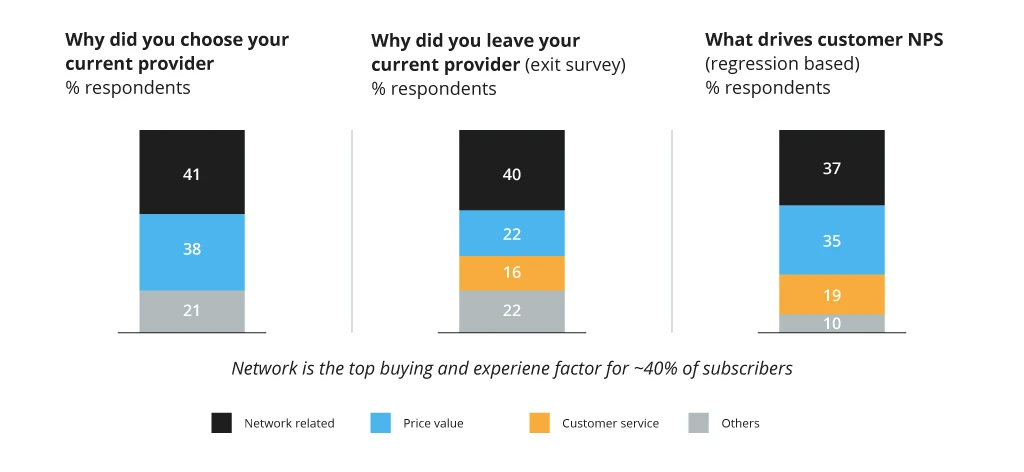Why Voice Testing Is Crucial for the Quality of Global Communications
Network Experience as One of the Leading Factors in Telco Customers' Decision-Making
At the same time, “voice” has become a complex channel as it is now powered by two standards: time division multiplexing (TDM) and Voice over IP (VoIP), each of which requires separate configurations, maintenance, and quality control.
Finally, services roaming remains one of the most profitable revenue streams for global telecoms. The global roaming tariff market size stood at $70,76 billion in 2020 and is expected to grow at a CAGR of 5.1% from 2021 to 2028. Data roaming, in turn, is reaching even more soaring heights with European operators reporting anywhere between 100%-450% increase in data roaming usage in 2022.
To tap into the revenue pools above, telecoms must ensure that their offerings are compliant with the global voice processing standards, established by organizations such as ITU-T, ETSI, and IETF among others. Without this compliance, telecoms cannot participate in roaming schemes, which puts your company at a disadvantage.
The obvious question is: How can telecoms improve customer experiences and establish new revenue pools? By setting up a proper voice interconnect process.
What Is Voice Interconnect?
Voice interconnect is the standardized process for exchanging signal data between fixed line or mobile network operators. The exchange can happen directly via clear public internet, private or public peering, using respective network exchange protocols (IP, Voice, Voice over IP, etc.)
Apart from enabling telecom traffic sharing, interconnect agreements also stipulate provisions for:
- Reciprocal compensation
- Acceptable service use
- Routing policies
- Dispute resolution
- SLA agreements
- QoS metrics
The above are standardized within business-level agreements and additionally governed by industry signaling standards with which all players must comply. Standards mostly stipulate how telcos should process traffic and how they should prevent quality issues.
Factors Affecting Voice Quality across VoIP and TDM Networks
Selected network architecture and utilized hardware determine the quality of voice services. To meet industry standardization requirements, your company must be able to identify and resolve the following issues:
TDM Networks
- Noise levels should not exceed -60dBm0. Be particularly mindful of sender side noises since they impact the speech signal before it is digitized. Receiver side noises, in turn, affect the signal as it leaves the network.
- Signal levels must be properly configured as well to avoid clipping or distortion (when the levels are too high) and noises (when the ratio is too low).
- Echo, especially when coupled with delay, can result in an especially poor communication experience.
- Legacy low bit-rate codecs can introduce distortion, so the network must be tested for that as well.
- Frame erasures can affect voice quality in mobile calls as they cause temporal clipping.
The above voice quality issues can occur anywhere in the call path. Therefore, telecoms must continuously monitor call quality and system performance throughout the network.
VoIP Networks
- Jitter occurs due to variable packet delivery, i.e., when packets arrive at different intervals. The disruption can happen instantly after the packets are sent by a wireless user, which complicates troubleshooting.
- Packet losses. Lost packets cannot be recovered in VoIP meaning that users lose parts of the conversations. Telecoms should strive for minimal levels of packet drops.
- Network delay and latency can be caused by both geographic distance and network utilization levels. When both parameters are high, callers experience high jitter.
- Codec. Using a codec with a low speech sampling rate can undermine the call quality. That said: codecs with high speech sampling rates consume more network bandwidth.
- Echo happens frequently, but is hard to detect since simultaneous analysis of several streams should be done with specialized tools and tests.
Challenges Voice Testing Services Solve for Telecoms
The primary goal of voice testing is to ensure compliance with the industry standards to enter peering agreements with business partners (RPs). A convenient “by-product” of compliance is also higher user-level quality of experience (QoE).
More specifically, voice testing helps telecom resolve the following challenges.
Achieve Standardization with Partners
The telecom industry has a specialized set of standards designed for Voice/VoIP interconnect quality measurement:
- ITU-T Recommendation, also known as voice service diagnosis framework.
- 3GPP specifications, encompassing various codecs for speech, audio, and video processing.
- ETSI standards, covering Speech and multimedia Transmission Quality (STQ).
- IETF RFC documents that involve a host of best practices for addressing, routing, and transport technologies.
Though the documents were originally designed as recommendations, most of them have actually become the default standards for carrier interoperability. Insufficient standardization on telco’s part, in turn, can result in telecoms’ inability to exchange effectively data with other operators.
Because of the above, your company may lose access to new profitable markets, as well as data roaming arrangements. The latter, in particular, may be a pressing issue. Juniper Research notes that $2 billion in potential roaming losses is on the line by 2026 as many telecoms struggle to distinguish between 4G and 5G roaming traffic using current standards.
Precise testing of your company’s current standardization levels, as well as your compatibility with selected telecom partner(s) done by an expert telecom team, can minimize the odds of the scenarios above.
Prevent Misinterpretation of Interconnect Requirements
Voice industry standards were designed to solve the interoperability issues — and most of them do so successfully. However, the devil is in the details. The formulation of various interconnect standards remains open to interpretation.
A standard requirements document contains keywords like:
- “Must or must not”
- “Required and Optional”
- “Recommended or Not Recommended”
- “May or Should”.
Because of such ambiguous formulations, different telecom teams can end up with a different network setup if they did what was “Required”, but skipped the “Recommended” part.
Subsequently, disputes may arise between two carriers whose teams insist on having the “correct” requirement implementation — a common scenario from our practice.
An experienced telecom testing team can help locate those discrepancies in requirements at both ends and help mediate the discussions on establishing interoperability.
Mitigate Hardware Fragmentation Issues
Voice quality also depends on the networking hardware supplied by the vendors. As you can imagine, few suppliers (if any) are compliant with all the industry standards. Respectively, telecoms might face situations where the selected equipment type is not compatible with a specific standard, employed in some geographic markets. Once again, it is best to identify this issue in advance and reach out to the manufacturer for extra support.
Address Country-Specific Requirements
Though Europe now has a Roam Like At Home (RLAH) policy, individual countries still impose local standards and certification requirements for foreign operators and wholesalers who wish to engage the local customer base.
For instance, your company might need to obtain the status of a domestic operator to offer a certain type of VoIP service (e.g., a cloud-based number with a local extension). To achieve this status, your company might be subject to extra certification requirements both on the software and hardware levels. Once again, testing helps uncover those.
How to Set Up an Effective Voice Quality Testing Process
To ensure a smooth go-to-market process for new voice products and avoid qualms with business partners, Infopulse telecom team suggests the following best practices.
Cover Your Bases with Pre-Production Voice Tests
Before entering the market with any new voice service, telecoms must conduct a series of standard voice tests. On our end, we can help your company select, fine-tune, and conduct these at a fast speed (within several days) and with high accuracy. Moreover, our years of experience in Voice/VoIP quality testing would ensure the best possible approach considering your resources and business needs.
Our engineers can monitor all the transmitted signal packets to locate any potential quality issues (e.g., delays in packet transmission that result in jitter). If any problem is detected, our team analyzes all the RFCs to locate their root cause and inform you about the inconsistency with respective specifications.
Typical List of Voice Interoperability Tests
Test
Expected Result
Optional/SIP RC
Call using codec G711A
Voice conversation
Call using codec G711u
Voice conversation
Call using codec G729(A)
Voice conversation
Call using codec G729B
Voice conversation
Fax (T38/G711)
Fax to be sent/received
User busy
SIP:486
600
Address incomplete
SIP:484
None
Unallocated number
SIP:404
485, 604
No answer from user
SIP:480
408
DTMF
Digits are sent/received
CLI
A-no. seen by b-party
Call failure due to saturation (max. sess)
503
400, 481
Cancel call before answer
487
Long call duration / Operator sends re-invite after 30 min
Configure Your Billing System in Line with Local Requirements
When entering a new business partnership, telecoms must ensure that their billing system can provide partner(s) with Call Detail Records (CDRs) in the correct format.
These data exchanges can become complex when your partner is in another time zone. In this case, telecoms have to ensure that your billing system can convert CDRs to other time zones so that your partner could then cross-match the records (and vice versa). Likewise, your records on the call duration should also correspond. Your company must ensure that you are not billing a caller after they have already hung up because that would result in an inconsistency with your partner’s records.
Therefore, it is crucial for your billing system to be accurately configured. Or else misunderstandings and financial disputes are bound to arise. Our engineering team can help your company to identify any mismatches in CDRs logs that could lead to collisions with telecom partners. Or provide a wider technology assessment of your billing system to identify its shortcomings and develop a strategy for replacing it with a better solution as we did for one of our clients.
Automate Manual Voice Testing Activities
To gain extra efficiencies, telecoms should eventually strive to bring automation to testing activities. But to have an understanding what activities could be optimized to bring business value, telecom-knowledge of QA is needed.
Telecom QA automation in general and in the context of voice testing leads to increased efficiency and granularity of executed tests. Once designed and implemented, your team can schedule automated test execution. For example, your company can run a test dialling system on a regular basis to monitor for inconsistencies in service quality.
Our recommendation is to look into automating both:
- Pre-production tests
- Post-production tests
This can be done with modern voice quality testing tools, based on Perceptual Objective Listening Quality Analysis (POLQA) and Perceptual Evaluation of Speech Quality (PESQ) standards. GL Communications, Mobileum, and EXFO are among the leaders in voice/VoIP specific testing software, whereas Mobileum offers comprehensive tools for voice, data, and messaging testing.
Final Thoughts
Telecoms worldwide are looking into new revenue streams and voice is still a profitable growth avenue. However, to access these growth opportunities and broker new partnerships, telecoms will have to pass the complex standardization process. Infopulse, a seasoned service provider, can help telecom businesses address the challenges and thrive in the new tech-savvy environment.
![Voice Testing for Telecom [banner]](https://www.infopulse.com/uploads/media/why-voice-testing-is-crucial-for-the-quality-of-global-communications-1920x528.webp)



![Expanding NOC into Service Monitoring [thumbnail]](/uploads/media/280x222-best-practices-of-expanding-telecom-noc.webp)
![Cloud-Native for Banking [thumbnail]](/uploads/media/cloud-native-solutions-for-banking_280x222.webp)
![Data Governance in Healthcare [thumbnail]](/uploads/media/blog-post-data-governance-in-healthcare_280x222.webp)
![Security Levels [thumbnail]](/uploads/media/thumbnail-280x222-levels-of-enterprise.webp)
![ServiceNow and Third-Party Integrations [thumbnail]](/uploads/media/thumbnail-280x222-how-to-integrate-service-now-and-third-party-systems.webp)
![5G Network Holes [Thumbnail]](/uploads/media/280x222-how-to-detect-and-predict-5g-network-coverage-holes.webp)
![DevOps Adoption Challenges [thumbnail]](/uploads/media/thumbnail-280x222-7-devops-challenges-for-efficient-adoption.webp)
![How to Reduce Churn in Telecom [thumbnail]](/uploads/media/thumbnail-280x222-how-to-reduce-churn-in-telecom-6-practical-strategies-for-telco-managers.webp)
![Automated Machine Data Collection for Manufacturing [Thumbnail]](/uploads/media/thumbnail-280x222-how-to-set-up-automated-machine-data-collection-for-manufacturing.webp)
![Azure Monitor for SAP [thumbnail]](/uploads/media/thumbnail-280x222-azure-monitor-for-sap-solutions-an-overview.webp)